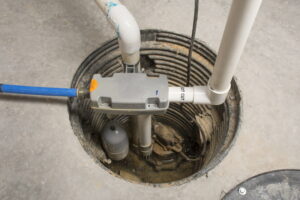 There are some things that are staples in American homes that household members hope they’ll never need—but when they do need them, they’re grateful they have them. Smoke alarms, carbon monoxide detectors, whole-house generators, fire extinguishers … these are just a few! And up there at the top of the list is the sump pump, essential in preventing water damage due to flooding that can come from stormy weather or even a plumbing mishap.
There are some things that are staples in American homes that household members hope they’ll never need—but when they do need them, they’re grateful they have them. Smoke alarms, carbon monoxide detectors, whole-house generators, fire extinguishers … these are just a few! And up there at the top of the list is the sump pump, essential in preventing water damage due to flooding that can come from stormy weather or even a plumbing mishap.
Of course, even though you hope you’ll never need it, this doesn’t mean you can ignore the sump pump. A sump pump should be tested at least once a season, and ideally after every time it gets used. Standing water within a crawlspace or basement is a major problem. It can severely damage the foundation of your home, rotting away wood and creating other hazards. For instance, it can raise the humidity level and encourage the growth of mold and mildew.
So testing the sump pump to make sure it’s always ready is essential to protecting your property. But how do you do this? Read on!
A Guide for Testing Your Sump Pump
Testing your sump pump on a routine basis is important. You could have a broken sump pump and not even know about it until an emergency arrives and you actually need it to do its job. But how do you test it, exactly?
Step #1
Check to see if the sump pump has power and if it turns on automatically. This means you need to find the outlet where the sump pump is plugged in. Go ahead and unplug it and plug it back in, kind of like you’re doing a “hard reboot.” If the sump pump turns on, so far so good.
If it doesn’t turn on, then you know that something is amiss and you can skip the following steps and just call our pros.
Step #2
Do a visual inspection. Do you see any cracks in the pump itself, or any fraying in the wiring? If so, then you want to give our qualified team a call so you don’t risk injury or further damage to the sump pump.
Step #3
Now we want you to pour water into the sump. The sump is the actual pit where the water collects. But first, clean the sump to ensure any debris inside is cleared out. This can include rocks, gravel, leaves, etc. You want the system as clean as possible before dumping a few gallons of water down into the sump.
If you have a pedestal sump pump, which is positioned above the sump, then watch the float as the water raises it. This should cause the pump to activate. In the case of a submersible model where the pump is located down in the sump itself, the pump should activate once the water rises above the pump intakes.
Remember, just because the sump pump activates doesn’t mean it’s working 100% right. Keep watching the pump to ensure it’s actually removing water.
Contact AllTech Services, Inc. for professional plumbing in Sterling, VA!

